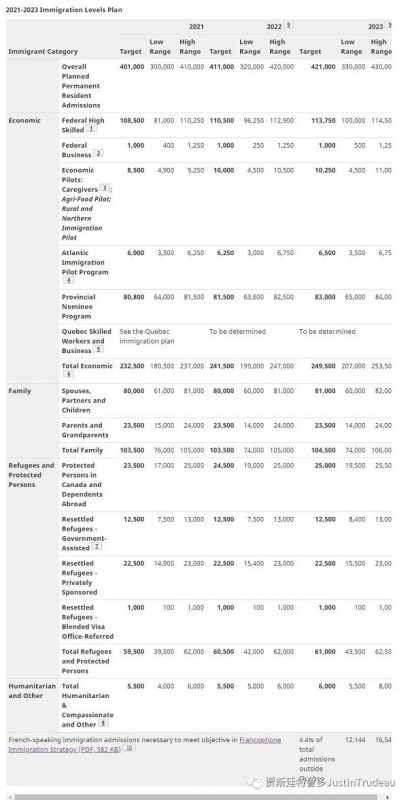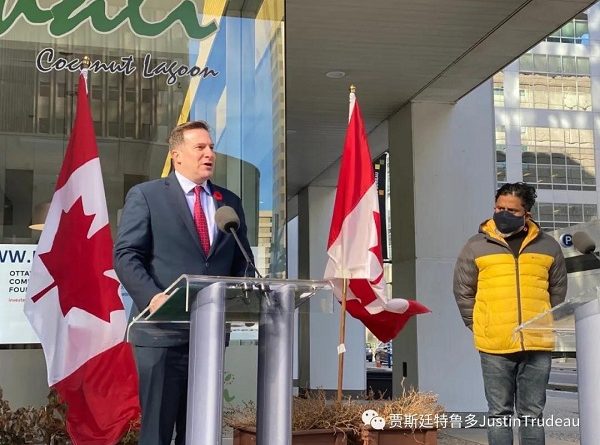通过移民支持经济复苏,加拿大联邦政府公布新计划
移民规模计划公布
增加移民以弥补今年缺口
注重经济增长创造就业

转:马守诺部长
(移民、难民及公民部)
短期经济复苏和长期繁荣的关键是移民。正因这样的原因,我们今天公布的加拿大移民计划提出了一个大胆的愿景,以支持加拿大🇨🇦的成功。
加拿大人知道,新移民在发挥着超越自我的作用,他们挺身而出填补了一些我们最严重的劳动力短缺,而且我们必须增加我们的人口,如果我们还希望利用所拥有的优势、并在世界舞台上保持竞争力。
新闻通稿
通过移民支持经济复苏,加拿大联邦政府公布新计划
Government of Canada announces plan to support economic recovery through immigration

源自:加拿大移民、难民及公民部
2020年10月30日-渥太华 — 联邦移民、难民和公民部长马守诺(Marco Mendicino,原译门迪奇诺)阁下今天提出了2021-2023年移民规模计划,规划了一条负责任地增加移民目标之路径,以帮助加拿大经济从COVID- 19疫情中复苏,推动未来的经济增长并为加拿大中产阶层创造就业机会。
当前的这场疫情大流行凸显了移民对我们社区及经济各行业的贡献。我们的医疗护理体系依赖移民来确保加拿大人的安全和健康。其他产业,例如信息技术公司以及我们的农民和生产者,也依靠新来者的才华来保持供应链、扩展生意并反过来为加拿大人创造更多的就业机会。

尽管加拿大移民、难民和公民部(IRCC)继续在整个疫情大流行中接受和处理申请,但由于全球旅行限制和容量限制,导致过去几个月的吸纳人数短缺。为了弥补这一缺口并确保加拿大拥有所需的工作人士来填补关键的劳动力市场空白,并在世界舞台上保持竞争力,2021年至2023年的规模计划旨在继续以加拿大人口的1%的比例迎接移民,其中包括2021年吸纳401,000名永久居民,2022年吸纳411,000名和2023年吸纳421,000名。先前的规模计划曾经设定2021年的目标为351,000名和2022吸纳361,000名。
加拿大人的健康、安全与保障仍然是我们的首要重点。加拿大已经加强了边境的卫生检查以及监控和执法,并将在我们欢迎新移民加入的同时,继续严格遵守公共卫生官员的建议。
这项跨越多年的规模计划认识到家庭团聚的重要性,以及加拿大通过安置难民来保护那些最受威胁之人士的全球承诺。

该计划的重点包括
在计划的三年中增加吸纳移民人数,以弥补2020年的缺口
专注于经济增长,约60%的吸纳移民将来自经济类移民
继续专注于具有创新性的和以社区为主导的方式,以解决全国各地的劳动力和人口多元化需求
再次承诺在加拿大移民体系中进行增大容量和数字化转型,以支持处理申请流程的运作并减轻COVID-19疫情对申请处理的影响
在“快速通道(EE)”项目中为讲法语的申请者提供额外计分,以促进魁北克省以外的法语社区的发展
致力于在未来两年内通过“经济流动途径项目”(Economic Mobility Pathways Project)接纳最多500名难民,这是一种创新的方法,帮助符合资格的难民通过现有的经济移民途径申请永久居留
为在抗击疫情一线工作的符合资格避难申请者提供一条通向永久居留的路径,只要他们在2020年3月13日至8月14日期间在疫情一线工作,为医疗护理机构的患者提供直接护理
2021年至2023年的移民规模计划将有助于巩固加拿大在全球人才流动中成为首要目的地之地位,为国民经济增长奠定坚实的基础,同时帮助家人与亲人团聚,并履行加拿大的人道主义承诺。

引述
移民、难民和公民部长马守诺(Marco Mendicino)阁下:
“移民不仅对帮助我们度过疫情大流行至关重要,而且也是我们的短期经济复苏和长期经济增长的必要因素。加拿大人已经看到了新移民如何在我们的医院和老人院中扮演着超越自身的角色,并帮助我们确保家中不断粮。在我们寻求复苏的过程中,新移民创造就业,不仅通过为我们的工商业提供兴旺所需的技能,而且他们还自己创业。我们的计划将有助于解决一些最严重的劳动力短缺问题,并增加我们的人口,保持加拿大在世界舞台上的竞争力。”

事实简要
在所有雇佣带薪员工的企业主中,移民占了33%,在我们的医疗行业中,25%的员工是移民。
《移民和难民保护法》要求政府每年在议会上提出移民规模计划。
移民规模计划是对每年将吸纳多少永久居民入境加拿大的一个预测,它设定了总体入境人数、以及每个移民类别的目标和范围。
移民规模计划考虑了与各省和地区代表的广泛互动,以及公众意见研究和对相关机构的咨询。
通过IRCC的“移民事关重要”( Immigration Matters)活动,全国各地的加拿大人可以了解新移民如何使当地社区受益。
根据《加拿大-魁北克协议》,魁北克设立自己的移民规模。

相关文件(英文)
2021‒2023 年移民规模计划及补充信息
2020关于移民事宜的议会年度报告
信息图:2019年的加拿大移民
2020年相关机构及人士咨询
下图:2021-2022年移民规划图

下图:2019年移民概况

下图:国际留学生请注意,由各省/区审批COVID-19疫情防备计划之后批准的“指定学习机构”名单现已就绪,可从网上查询。所有旅行者必须制定抵达加拿大后自我隔离14天的计划。

英文原文
News Release
Government of Canada announces plan to support economic recovery through immigration
From: Immigration, Refugees and Citizenship Canada
News release
October 30, 2020—Ottawa—The Honourable Marco Mendicino, Minister of Immigration, Refugees and Citizenship, tabled the 2021‒2023 Immigration Levels Plan today, which sets out a path for responsible increases to immigration targets to help the Canadian economy recover from COVID-19, drive future growth and create jobs for middle class Canadians.
The pandemic has highlighted the contribution of immigrants to the well-being of our communities and across all sectors of the economy. Our health-care system relies on immigrants to keep Canadians safe and healthy. Other industries, such as information technology companies and our farmers and producers, also rely on the talent of newcomers to maintain supply chains, expand their businesses and, in turn, create more jobs for Canadians.
Although Immigration, Refugees and Citizenship Canada (IRCC) continued to accept and process applications throughout the pandemic, the global travel restrictions and capacity constraints led to a shortfall in admissions over the last several months. To compensate for the shortfall and ensure Canada has the workers it needs to fill crucial labour market gaps and remain competitive on the world stage, the 2021 to 2023 levels plan aims to continue welcoming immigrants at a rate of about 1% of the population of Canada, including 401,000 permanent residents in 2021, 411,000 in 2022 and 421,000 in 2023. The previous plan set targets of 351,000 in 2021 and 361,000 in 2022.
The health, safety and security of Canadians remain our top priorities. Canada has strengthened health screening at the border as well as monitoring and enforcement, and will continue to closely follow the advice of public health officials as we welcome newcomers.
This multi-year levels plan recognizes the importance of family reunification and Canada’s global commitment to protecting those most at risk through refugee resettlement.
Highlights of the plan include
an increase in admissions over the 3 years of the plan to make up the shortfall in 2020
a focus on economic growth, with about 60% of admissions to come from the Economic Class
a continued focus on innovative and community-driven approaches to address diverse labour and demographic needs across the country
a renewed commitment to capacity-building and digital transformation in Canada’s immigration system, to support operations and mitigate the impacts of COVID-19 on the processing of applications
additional points for French-speaking candidates under Express Entry, to promote the growth of Francophone communities outside of Quebec
a commitment to admit up to 500 refugees over the next 2 years through the Economic Mobility Pathways Project, an innovative approach that helps qualified refugees apply for permanent residence through existing economic immigration pathways
a pathway to permanent residency for eligible asylum claimants who were working on the front lines of the pandemic between March 13 and August 14, 2020, providing direct care to patients in health-care institutions
The 2021–2023 Immigration Levels Plan will help cement Canada’s place among the world’s top destinations for talent, creating a strong foundation for economic growth while reuniting family members with their loved ones and fulfilling Canada’s humanitarian commitments.
Quotes
“Immigration is essential to getting us through the pandemic, but also to our short-term economic recovery and our long-term economic growth. Canadians have seen how newcomers are playing an outsized role in our hospitals and care homes, and helping us to keep food on the table. As we look to recovery, newcomers create jobs not just by giving our businesses the skills they need to thrive, but also by starting businesses themselves. Our plan will help to address some of our most acute labour shortages and to grow our population to keep Canada competitive on the world stage.”
– The Honourable Marco E. L. Mendicino, P.C., M.P., Minister of Immigration, Refugees and Citizenship
Quick facts
Immigrants account for 33% of all business owners with paid staff, and 25% of workers in our health sector are immigrants.
The Immigration and Refugee Protection Act requires the levels plan be tabled in Parliament each year.
The levels plan is a projection of how many permanent residents will be admitted to Canada, setting targets and ranges for overall admissions, as well as for each immigration category.
The levels plan takes into account extensive engagement with provincial and territorial representatives, as well as public opinion research and stakeholder consultations.
Canadians across the country can see how newcomers are benefiting local communities through IRCC’s Immigration Matters campaign.
Under the Canada-Quebec Accord, Quebec establishes its own immigration levels.
Related products
2021‒2023 Immigration Levels Plan and Supplementary Information
2020 Annual Report to Parliament on Immigration
Infographic: Immigration to Canada in 2019
2020 Stakeholder Consultations
来源:加拿大总理办公室
2020年10月31日





